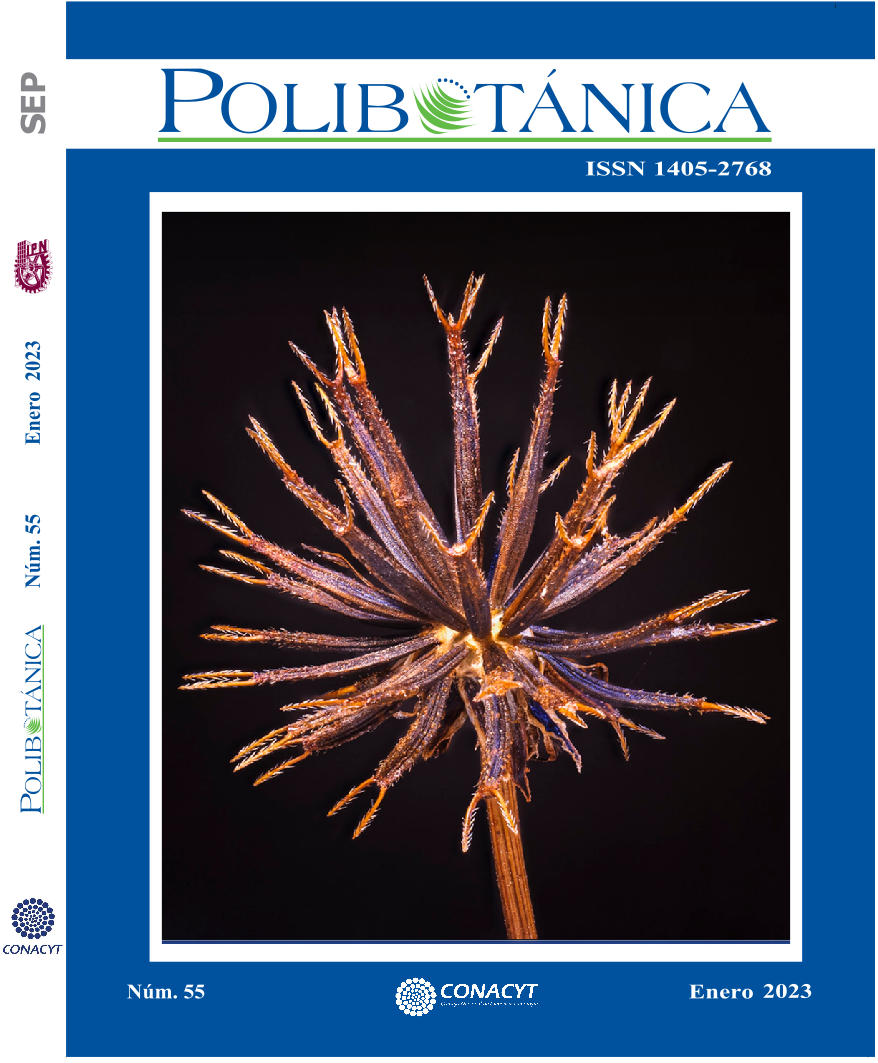Kinetin concentration and explant type in in vitro multiplication of Sequoia sempevirens D. Don. Endl.
DOI:
https://doi.org/10.18387/polibotanica.55.6Keywords:
Sprouting, kinetin concentrations, micropropagation, vegetative propagationAbstract
Sequoia sempervirens is the tallest tree in the world, it has a low germination percentage (10 %), and due to it the in vitro tissue culture has been used for its propagation. Even so, the multiplication technique development is still not efficient. This work aimed to the development of an efficient protocol for in vitro multiplication of S. sempervirens, using apical and basal stem explants, and a culture medium with a low concentration of mineral salts. Twenty axillary buds from an 18-years-old tree were established in vitro, after three subcultures, three experiments were established every six weeks. Kinetin (6- furfuryl- aminopurin) concentrations (0, 0.92, 1.85 y 3.71 µM) and two types of explants: apical and basal, were evaluated. The parameters evaluated were: height increase, over time growth, and number of axillary shoots emitted by explant type. The height increase for the three experiments was in apical explants (2.35, 4.26, and 4.78 cm) with 0 µM kinetin. The greatest increases in height of apical explants (2.35, 4.26 and 4.78 cm) were obtained with 0 μM of kinetin, in the three experiments. The greatest increases in height were in all evaluated treatments in the second and the fourth week. The greatest number of axillary shoots (2.11) were obtained in basal explants. The in vitro propagation protocol for S. sempervirens using apical and basal explants is efficient, the growth of the explants were successful with 12.38 mm of total nitrogen in culture medium.
References
Chen, C.-C., Bates, R., & Carlson, J. (2015). Effect of environmental and cultural conditions in medium pH and plant growth performance of Douglas-fir (Pseudotsuga menziesii) shoot culture. F1000Research, 3(0), 1–16. https://doi.org/10.12688/f1000research.5919.1
Chen, L. R., Hsiung, T. C., Lin, K. H., Huang, T. Bin, Huang, M. Y., & Wakana, A. (2017). Supplementary effect of hydrogen peroxide as a pre-disinfectant for sterilizing rhizome bud explants of Zantedeschia aethiopica L. With Chlorine Dioxide. Journal of the Faculty of Agriculture, Kyushu University, 62(1), 81–86. https://doi.org/10.5109/1799306
Clapa, D., Fira, A., Hǎrşan, E., Chiş, L., Roman, G., & Cantor, M. (2010). Sequoia sempervirens in Transylvania. Acta Horticulturae, 885(October 2017), 85–90. https://doi.org/10.17660/ActaHortic.2010.885.11
da Rocha, P. S. G., de Oliveira, R. P., & Scivittaro, W. B. (2015). New light sources for in-vitro potato micropropagation. Bioscience Journal, 31(5), 1312–1318. https://doi.org/10.14393/BJ-v31n5a2015-26601
Davies, N. T., Wu, H. F., & Altaner, C. M. (2014). The chemistry and bioactivity of various heartwood extracts from redwood (Sequoia sempervirens) against two species of fungi. New Zealand Journal of Forestry Science, 44(1), 1–12. https://doi.org/10.1186/s40490-014-0017-4
de Oliveira, L. M., Paiva, R., Ferreira de Santana, Raniere, J., Pereira, F. D., Nogueira, R. C., & Silva, L. C. (2010). Effects of cytokinins on in vitro mineral accumulation and bud development in Annona glabra L. Ciencia e Agrotecnologia, 34(6), 1439–1445. https://doi.org/10.1590/s1413-70542010000600012
El-kadder, E. M. A., & Fathy, H. (2012). Production of Indole Acetic Acid from Sequoia sempervirens and its Reuse Under In Vitro Culture. Research Journal of Agriculture and Biological Sciences, 8(2), 167–173.
Francisdo de Oliveira, L., Ribas, L. L. F., Quoirin, M., Koehler, H. S., & Higa, A. R. (2011). Micropropagation of Pinus taedaL. via axillary buds. BMC Proceedings, 5(P144), 1–3. https://doi.org/10.1186/1753-6561-5-s7-p144
Hill, K., & Schaller, G. E. (2013). Enhancing plant regeneration in tissue culture: A molecular approach through manipulation of cytokinin sensitivity. Plant Signaling and Behavior, 8(10). https://doi.org/10.4161/psb.25709
Liu, C., Xia, X., Yin, W., Huang, L., & Zhou, J. (2006). Shoot regeneration and somatic embryogenesis from needles of redwood (Sequoia sempervirens (D.Don.) Endl.). Plant Cell Reports, 25(7), 621–628. https://doi.org/10.1007/s00299-006-0120-y
Meneguzzi, A., Konzen, E. R., Navroski, M. C., Camargo, S. S., Pereira, M. D. O., Rufato, L., & Lovatel, Q. C. (2019). Shoot multiplication of two <em>Sequoia sempervirens </em> genotypes with addition of small concentrations of kinetin. Pesquisa Florestal Brasileira, 39(1). https://doi.org/10.4336/2019.pfb.39e201701550
Molinos Da Silva, C., Villegas Monter, Á., Sánchez García, P., Alcántar González, G., Rodríguez Mendoza, M. N., & Ruíz Posadas, L. del M. (2004). Efectos del potencial osmótico y contenido de Ca en el medio de cultivo sobre la distribución de Ca2 + Y K +, producción de biomasa y necrosis apical de vid R110. Interciencia, 29(7), 384–388.
Murashige, T., & Skooge, F. (1962). A Revised Medium for Rapid Growth and Bio Assays with Tobacco Tissue Cultures. Phytsiologia Plantarum, 15(3), 473–497. https://doi.org/10.1016/S0031-9422(01)00179-0
Olson, D. F., Roy, D. F., & Walters, G. A. (1990). Sequoia sempervirens (D. Don) Endl. In R. M. Barnes & B. H. Honkala (Eds.), Silvics of North America. Agriculture handbook 654 (pp. 541–551). Washington, DC, USA: USDA Forest Service.
Ozudogru, E. A., Kirdok, E., Kaya, E., Capuana, M., De Carlo, A., & Engelmann, F. (2011). Medium-term conservation of redwood (Sequoia sempervirens (D. Don.) Endl.) in vitro shoot cultures and encapsulated buds. Scientia Horticulturae, 127(3), 431–435. https://doi.org/10.1016/j.scienta.2010.10.013
Pereira, M. de O., Ângelo, A. C., Navroski, M. C., Dobner Júnior, M., & De Oliveira, L. M. (2017). Resgate vegetativo e enraizamento de estacas de diferentes matrizes de Sequoia sempervirens. Cerne, 23(4), 435–444. https://doi.org/10.1590/01047760201723042452
Puddephat, I. J., Alderson, P. G., & Wright, N. A. (1997). Influence of explant source, plant growth regulators and culture environment on culture initiation and establishment of Quercus robur L. in vitro. Journal of Experimental Botany, 48(309), 951–962. https://doi.org/10.1093/jxb/48.4.951
Raya- Montaño, Y. A., Villegas- Monter, A., & Arellano-Ostoa, G. (2009). Cinética de enraizamiento in vitro de portainjertos de vid en respuesta a la fuente y concentración de azúcar. Revista Fitotecnia Mexicana, 32(2), 111–117.
Ribeiro, J. M., Teixeira, S. L., & Bastos, D. C. (2011). Cultivo in vitro de Sequoia sempervirens L. em meio de nutritivo esterilizado com hipoclorito de sódio. Ciência Florestal, 21(1), 77–82.
Rios, G., Añez, N., Ramírez, M., Bracho, B., Araujo, D., Suárez, H., & Nava, J. (2013). Cultivo in Vitro de yemas, tratadas con benciladenina, provenientes de cormos enteros o seccionados de plátano “Cambur manzano.” Bioagro, 25(2), 137–142.
Rojas Vargas, A., Castander-Olarieta, A., Moncaleán, P., & Montalbán, I. A. (2021). Optimization of the micropropagation of elite adult trees of Sequoia sempervirens: Forest species of interest in the Basque Country, Spain. Revista Bionatura, 6(1), 1511–1519. https://doi.org/10.21931/RB/2021.01.01.11
Sato, A. Y., Pereira Pinto, J. E., Morais, A. R. De, Lameira, O. A., & de Castro, N. E. (2001). Efeito de diferentes níveis de nitrogênio, em presença ou ausência de benzilaminopurina, na multiplicação de gérbera (Gerbera sp.) de vaso. Ciência e Agrotecnologia, Lavras, 25(5), 1071–1078.
Singha, S., Oberly, G. H., & Townsend, E. C. (1987). Changes in nutrient composition and pH of the culture medium during in vitro shoot proliferation of crabapple and pear. Plant Cell, Tissue and Organ Culture, 11(3), 209–220. https://doi.org/10.1007/BF00040426
Suárez Román, R. S., Caetano, C. M., Ramírez, H., & Morales Osorio, J. G. (2014). Multiplicación de Selenicereus megalanthus (pitahaya amarilla) e Hylocereus polyrhizus (pitahaya roja) vía organogénesis somática. Acta Agronomica, 63(3), 1–14. https://doi.org/10.15446/acag.v63n3.40980
Tanaka, M., Takei, K., Kojima, M., Sakakibara, H., & Mori, H. (2006). Auxin controls local cytokinin biosynthesis in the nodal stem in apical dominance. Plant Journal, 45(6), 1028–1036. https://doi.org/10.1111/j.1365-313X.2006.02656.x
Toral Ibañez, M., Caru, M., Herrera, M. A., Gonzalez, L., Martin, L. M., Miranda, J., & Navarro-Cerrillo, R. M. (2009). Clones identification of Sequoia sempervirens (D. Don) Endl. in Chile by using PCR-RAPDs technique. Journal of Zhejiang University: Science B, 10(2), 112–119. https://doi.org/10.1631/jzus.B0820162
Victório, C. P., Lage, C. L. S., & Sato, A. (2012). Tissue culture techniques in the proliferation of shoots and roots of Calendula officinalis. Revista Ciencia Agronomica, 43(3), 539–545. https://doi.org/10.1590/S1806-66902012000300017
Whan Sul, I., & Korban, S. S. (1994). Effect of different cytokinins on axillary shoot proliferation and elongation of several genotypes of Sequoia sempervirens. In Vitro Cellular & Developmental Biology-Plant, 30(3), 131–135. https://doi.org/10.2307/j.ctt1ffjkd5.19
Wolter, K. E., & Skoog, F. (1966). Nutritional Requirements of Fraxinus Callus Cultures. American Journal of Botany, 53(3), 263–269. https://doi.org/10.1002/j.1537-2197.1966.tb07333.x
Zhang, K., Wu, Y., & Hang, H. (2019). Differential contributions of NO3-/NH4+ to nitrogen use in response to a variable inorganic nitrogen supply in plantlets of two Brassicaceae species in vitro. Plant Methods, 15(1), 1–12. https://doi.org/10.1186/s13007-019-0473-1
Downloads
Published
Issue
Section
License

Polibotánica by Departamento de Botánica de la Escuela Nacional de Ciencias Biológicas del Instituto Politécnico Nacional se distribuye bajo una Licencia Creative Commons Atribución-NoComercial-CompartirIgual 4.0 Internacional.



















